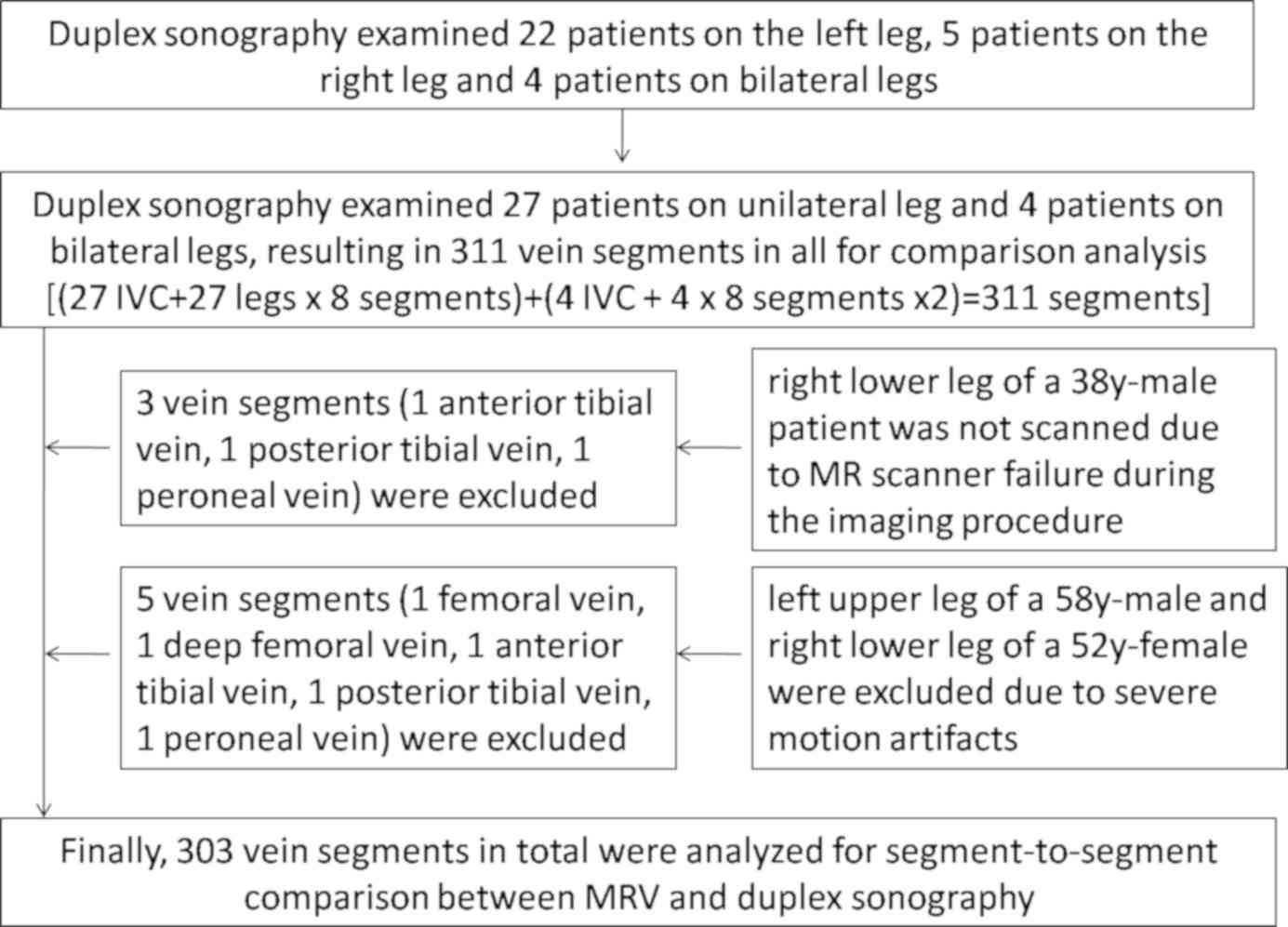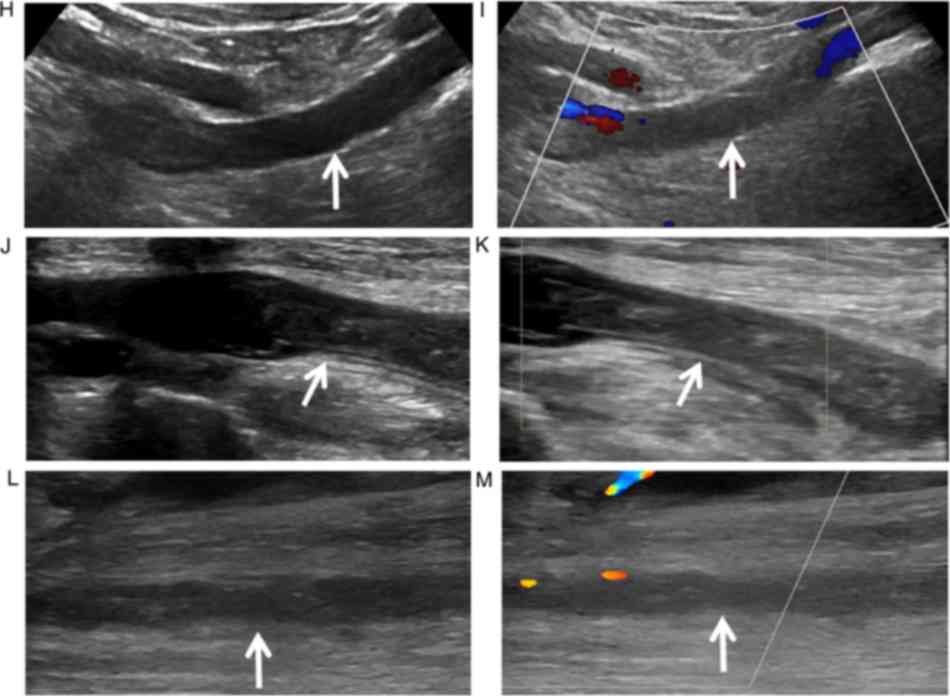|
1
|
Kearon C, Ginsberg JS, Douketis J,
Crowther MA, Turpie AG, Bates SM, Lee A, Brill-Edwards P, Finch T
and Gent M: A randomized trial of diagnostic strategies after
normal proximal vein ultrasonography for suspected deep venous
thrombosis: D-dimer testing compared with repeated ultrasonography.
Ann Intern Med. 142:490–496. 2005.PubMed/NCBI View Article : Google Scholar
|
|
2
|
Gaitini D: Multimodality imaging of the
peripheral venous system. Int J Biomed Imaging.
2017(54616)2007.PubMed/NCBI View Article : Google Scholar
|
|
3
|
Eikelboom JW, Hirsh J, Spencer FA, Baglin
TP and Weitz JI: Antiplatelet drugs: Antithrombotic therapy and
prevention of thrombosis, 9th ed: American College of chest
physicians evidence-based clinical practice guidelines. Chest. 141
(2 Suppl):e89S–e119S. 2012.PubMed/NCBI View Article : Google Scholar
|
|
4
|
Loud PA, Grossman ZD, Klippenstein DL and
Ray CE: Combined CT venography and pulmonary angiography: A new
diagnostic technique for suspected thromboembolic disease. AJR Am J
Roentgenol. 170:951–954. 1998.PubMed/NCBI View Article : Google Scholar
|
|
5
|
Rademaker J, Griesshaber V, Hidajat N,
Oestmann JW and Felix R: Combined CT pulmonary angiography and
venography for diagnosis of pulmonary embolism and deep vein
thrombosis: Radiation dose. J ThoracImag. 16:297–299.
2001.PubMed/NCBI View Article : Google Scholar
|
|
6
|
Karande GY, Hedgire SS, Sanchez Y, Baliyan
V, Mishra V, Ganguli S and Prabhakar AM: Advanced imaging in acute
and chronic deep vein thrombosis. Cardiovasc Diagn Ther. 6:493–507.
2016.PubMed/NCBI View Article : Google Scholar
|
|
7
|
Carpenter JP, Holland GA, Baum RA, Owen
RS, Carpenter JT and Cope C: Magnetic resonance venography for the
detection of deep venous thrombosis: Comparison with contrast
venography and duplex Doppler ultrasonography. J Vasc Surg.
18:734–741. 1993.PubMed/NCBI View Article : Google Scholar
|
|
8
|
Ozbudak O, Eroğullari I, Öğüş C, Çilli A,
Türkay M and Özdemir T: Doppler ultrasonography versus venography
in the detection of deep vein thrombosis in patients with pulmonary
embolism. J Thromb Thrombolys. 21:159–162. 2006.PubMed/NCBI View Article : Google Scholar
|
|
9
|
Labropoulos N, Borge M, Pierce K and
Pappas PJ: Criteria for defining significant central vein stenosis
with duplex ultrasound. J Vasc Surg. 46:101–107. 2007.PubMed/NCBI View Article : Google Scholar
|
|
10
|
Huang SY, Kim CY, Miller MJ, Gupta RT,
Lessne ML, Horvath JJ, Boll DT, Evans PD, Befera NT, Krishnan P, et
al: Abdominopelvic and lower extremity deep venous thrombosis:
Evaluation with contrast-enhanced MR venography with a blood-pool
agent. AJR Am J Roentgenol. 201:208–214. 2013.PubMed/NCBI View Article : Google Scholar
|
|
11
|
Gary T, Steidl K, Belaj K, Hafner F,
Froehlich H, Deutschmann H, Pilger E and Brodmann M: Unusual deep
vein thrombosis sites: Magnetic resonance venography in patients
with negative compression ultrasound and symptomatic pulmonary
embolism. Phlebology. 29:25–29. 2014.PubMed/NCBI View Article : Google Scholar
|
|
12
|
Goodacre S, Sampson F, Thomas S, van Beek
E and Sutton A: Systematic review and meta-analysis of the
diagnostic accuracy of ultrasonography for deep vein thrombosis.
BMC Med Imaging. 5(6)2005.PubMed/NCBI View Article : Google Scholar
|
|
13
|
Sampson FC, Goodacre SW, Thomas SM and van
Beek EJ: The accuracy of MRI in diagnosis of suspected deep vein
thrombosis: Systematic review and meta-analysis. Eur Radiol.
17:175–181. 2007.PubMed/NCBI View Article : Google Scholar
|
|
14
|
Ruehm SG, Wiesner W and Debatin JF: Pelvic
and lower extremity veins: Contrast-enhanced three-dimensional MR
venography with a dedicated vascular coil-initial experience.
Radiology. 215:421–427. 2000.PubMed/NCBI View Article : Google Scholar
|
|
15
|
Tan M, Mol GC, van Rooden CJ, Klok FA,
Westerbeek RE, Iglesias Del Sol A, van de Ree MA, de Roos A and
Huisman MV: Magnetic resonance direct thrombus imaging
differentiates acute recurrent ipsilateral deep vein thrombosis
from residual thrombosis. Blood. 124:623–627. 2014.PubMed/NCBI View Article : Google Scholar
|
|
16
|
Westerbeek RE, Van Rooden CJ, Tan M, Van
Gils AP, Kok S, De Bats MJ, De Roos A and Huisman MV: Magnetic
resonance direct thrombus imaging of the evolution of acute deep
vein thrombosis of the leg. J ThrombHaemost. 6:1087–1092.
2008.PubMed/NCBI View Article : Google Scholar
|
|
17
|
Rofsky NM, Lee VS, Laub G, Pollack MA,
Krinsky GA, Thomasson D, Ambrosino MM and Weinreb JC: Abdominal MR
imaging with a volumetric interpolated breath-hold examination.
Radiology. 212:876–884. 1999.PubMed/NCBI View Article : Google Scholar
|
|
18
|
Pfeil A, Betge S, Poehlmann G, Boettcher
J, Drescher R, Malich A, Wolf G, Mentzel H and Hansch A: Magnetic
resonance VIBE venography using the blood pool contrast agent
gadofosveset trisodium-An interrater reliability study. Eur J
Radiol. 81:547–552. 2012.PubMed/NCBI View Article : Google Scholar
|
|
19
|
Hansch A, Betge S, Poehlmann G, Neumann S,
Baltzer P, Pfeil A, Waginger M, Boettcher J, Kaiser WA, Wolf G and
Mentzel HJ: Combined magnetic resonance imaging of deep venous
thrombosis and pulmonary arteries after a single injection of a
blood pool contrast agent. Eur Radiol. 21:318–325. 2011.PubMed/NCBI View Article : Google Scholar
|
|
20
|
Michaely HJ, Attenberger UI, Dietrich O,
Schmitt P, Nael K, Kramer H, Reiser MF, Schoenberg SO and Walz M:
Feasibility of gadofosveset-enhanced steady-state magnetic
resonance angiography of the peripheral vessels at 3 Tesla with
Dixon fat saturation. Invest Radiol. 43:635–641. 2008.PubMed/NCBI View Article : Google Scholar
|
|
21
|
Kluge A, Mueller C, Strunk J, Lange U and
Bachmann G: Experience in 207 combined MRI examinations for acute
pulmonary embolism and deep vein thrombosis. AJR Am J Roentgenol.
186:1686–1696. 2006.PubMed/NCBI View Article : Google Scholar
|
|
22
|
Delfaut EM, Beltran J, Johnson G, Rousseau
J, Marchandise X and Cotten A: Fat suppression in MR imaging:
Techniques and pitfalls. Radiographics. 19:373–382. 1999.PubMed/NCBI View Article : Google Scholar
|
|
23
|
Wells PS, Anderson DR, Rodger M, Forgie M,
Kearon C, Dreyer J, Kovacs G, Mitchell M, Lewandowski B and Kovacs
MJ: Evaluation of D-dimer in the diagnosis of suspected deep-vein
thrombosis. N Engl J Med. 349:1227–1235. 2003.PubMed/NCBI View Article : Google Scholar
|
|
24
|
Killewich LA, Bedford GR, Beach KW and
Strandness DJ: Diagnosis of deep venous thrombosis. A prospective
study comparing duplex scanning to contrast venography.
Circulation. 79:810–814. 1989.PubMed/NCBI View Article : Google Scholar
|
|
25
|
Landis JR and Koch GG: The measurement of
observer agreement for categorical data. Biometrics. 33:159–174.
1977.PubMed/NCBI
|
|
26
|
Bashir MR, Mody R, Neville A, Javan R,
Seaman D, Kim CY, Gupta RT and Jaffe TA: Retrospective assessment
of the utility of an iron-based agent for contrast-enhanced
magnetic resonance venography in patients with endstage renal
diseases. J Magn Reson Imaging. 40:113–118. 2014.PubMed/NCBI View Article : Google Scholar
|
|
27
|
Ragan DK and Bankson JA: Two-point Dixon
technique provides robust fat suppression for multi-mouse imaging.
J Magn Reson Imaging. 31:510–514. 2010.PubMed/NCBI View Article : Google Scholar
|
|
28
|
Ma J, Vu AT, Son JB, Choi H and Hazle JD:
Fat-suppressed three-dimensional dual echo Dixon technique for
contrast agent enhanced MRI. J Magn Reson Imaging. 23:36–41.
2006.PubMed/NCBI View Article : Google Scholar
|
|
29
|
Reeder SB, McKenzie CA, Pineda AR, Yu H,
Shimakawa A, Brau AC, Hargreaves BA, Gold GE and Brittain JH:
Water-fat separation with IDEAL gradient-echo imaging. J Magn Reson
Imaging. 25:644–652. 2007.PubMed/NCBI View Article : Google Scholar
|
|
30
|
Fraser DG, Moody AR, Davidson IR, Martel
AL and Morgan PS: Deep venous thrombosis: Diagnosis by using venous
enhanced subtracted peak arterial MR venography versus conventional
venography. Radiology. 226:812–820. 2003.PubMed/NCBI View Article : Google Scholar
|
|
31
|
Elias A, Cadène A, Elias M, Puget J,
Tricoire JL, Colin C, Lefebvre D, Rousseau H and Joffre F: Extended
lower limb venous ultrasound for the diagnosis of proximal and
distal vein thrombosis in asymptomatic patients after total hip
replacement. Eur J Vasc Endovasc Surg. 27:438–444. 2004.PubMed/NCBI View Article : Google Scholar
|
|
32
|
Forbes K and Stevenson AJ: The use of
power Doppler ultrasound in the diagnosis of isolated deep venous
thrombosis of the calf. Clin Radiol. 53:752–754. 1998.PubMed/NCBI View Article : Google Scholar
|
|
33
|
Mattos MA, Melendres G, Sumner DS, Hood
DB, Barkmeier LD, Hodgson KJ and Ramsey DE: Prevalence and
distribution of calf vein thrombosis in patients with symptomatic
deep venous thrombosis: A color-flow duplex study. J Vasc Surg.
24:738–744. 1996.PubMed/NCBI View Article : Google Scholar
|
|
34
|
Mumoli N, Mastroiacovo D,
Giorgi-Pierfranceschi M, Pesavento R, Mochi M, Cei M, Pomero F,
Mazzone A, Vitale J, Ageno W and Dentali F: Ultrasound elastography
is useful to distinguish acute and chronic deep vein thrombosis. J
Thromb Haemost. 16:2482–2491. 2018.PubMed/NCBI View Article : Google Scholar
|
|
35
|
Pressacco J, Papas K, Lambert J, Paul Finn
J, Chauny JM, Desjardins A, Irislimane Y, Toporowicz K, Lanthier C,
Samson P, et al: Magnetic resonance angiography imaging of
pulmonary embolism using agents with blood pool properties as an
alternative to computed tomography to avoid radiation exposure. Eur
J Radiol. 113:165–173. 2019.PubMed/NCBI View Article : Google Scholar
|
|
36
|
Fischer S, Grodzki DM, Domschke M,
Albrecht M, Bodelle B, Eichler K, Hammerstingl R, Vogl TJ and
Zangos S: Quiet MR sequences in clinical routine: Initial
experience in abdominal imaging. Radiol Med. 122:194–203.
2017.PubMed/NCBI View Article : Google Scholar
|
|
37
|
Baek HJ, Choo KS, Nam KJ, Hwang J, Lee JW,
Kim JY and Jung HJ: Comparison of image qualities of 80 kVp and 120
kVp CT venography using Model-Based iterative reconstruction at
same radiation dose. J Korean Soc Radiol. 78:235–241. 2018.
View Article : Google Scholar
|
















